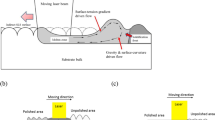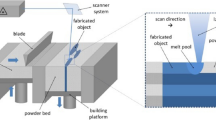Abstract
To date only gas-atomised tool steel powders have been used for direct laser additive manufacturing and the potential benefits of using water-atomised powders have not been explored. As the use of the process in the rapid tooling field is growing, there is a need to explore if the less expensive water-atomised materials can be realistically utilised. A comparative investigation is described, using gas- and water-atomised H13 powder deposited with a CO2 laser and coaxial powder feed nozzle. Multiple layer wall dimensions, composition, microstructure, surface finish and hardness are related to process conditions and the causes of the observed phenomena are discussed. An energy-balance method is used to model the temperature of the powders and the results used to explain some of the effects. Results indicate that using the lower cost water-atomised powder still allows a metallurgically sound component to be built and does not significantly affect surface finish. The build rate is, however, lower and the water-atomised powder tends to produce slightly softer walls, attributable to a higher temperature during tempering of deposited material by subsequent laser passes.
Similar content being viewed by others
References
Backes G, Kreutz EW, Gasser A, Hoffmann E, Ketgen S, Wissenbach K, Poprawe R (1998) Laser-shape reconditioning and manufacturing of tools and machine parts. Proceedings of ICALEO’98, Orlando, FL, pp E48–56
Liu W, DuPont JN (2003) Fabrication of functionally graded TiC/Ti composites by laser engineered net shaping. Scripta Materialia 48(9):1337–1342
Mazumder J, Choi J, Nagarathnam K, Koch J, Hetzner D (1997) The direct metal deposition of H13 tool steel for 3-D components. JOM 49(5):55–60
Marcus HL, Beaman JJ, Barlow JW, Bourell DL (1990) From computer to component in 15 minutes. The integrated manufacture of three-dimensional objects. JOM 42(4):8–10
Karatas C, Saritas S (2001) Rheological properties of mixed gas and water atomized stainless steel powder MIM feedstock. Int J Powder Metall 37(8):39–44
Pinkerton AJ, Li L (2002) A comparative study of multiple layer laser deposition using water- and gas-atomised 316L stainless steel powders. Proceedings of ICALEO’02, Scottsdale, AZ
Pinkerton AJ, Li L (2003) Process characteristics and effects of gas- and water-atomised stainless steel powders in laser-based rapid tooling. J Laser Appl 15(3):172–178
Pinkerton AJ, Li L (2003) Rapid prototyping using direct laser deposition – the effect of powder atomisation type and flow rate. Proceedings of the I.Mech.E. B. J Eng Manuf 217(6):741–752
Pinkerton AJ, Li L (2003) Effects of powder geometry and composition in coaxial laser deposition of 316L steel for rapid prototyping. Ann CIRP 52(1):181–184
Wilson R (1975) Metallurgy and heat treatment of tool steels. McGraw-Hill, London, pp 41–50
Pelletier JM (1996) Laser surface treatment, state of the art and prospects. Proceedings of SPIE 2789, pp 93–103
Pinkerton AJ, Li L (2002) A verified model of the behaviour of the axial powder stream concentration from a coaxial laser cladding nozzle, Proceedings of ICALEO’02, Scottsdale, AZ
Meriaudeau F, Truchetet F (1996) Control and optimisation of the laser cladding process using matrix cameras and image processing. J Laser Appl 8:317–324
Wilson R, (1975) Metallurgy and heat treatment of tool steels. McGraw-Hill, London, pp 70–77
Payson P (1962) The metallurgy of tool steels. Wiley, New York, pp 4–8
ASM International (1990) ASME Metals Handbook, 10th edn, vol 1, p 431
Brooks J, Robino C, Headley T, Goods S, Griffith M (1999) Microstructure and property optimization of LENS deposited H13 tool steel. Proceedings of Solid Freeform Fabrication Symposium, pp 375–382
Chaoui N, Pasquet P, Solis J, Afonso CN, Oltra R (2002) In situ diagnostics and control of laser-induced removal of iron oxide layers. Surf Coatings Technol 150(1):57–63
Dautzenberg N, Gesell H (1976) Production techniques and properties of austenitic Cr-Ni stainless steel powders. Powder Metall Int 8(1):14–17
McLean MA, Shannon GJ, Steen WM (1997) Laser direct casting high nickel alloy components. Adv Powder Metall Part Mater 3(21):3–16
McLean MA, Shannon GJ, Steen WM (1997) Laser generating metallic components. Proceedings of SPIE, 3092, pp 753–756>
Lin J (2000) Laser attenuation of the focused powder stream in coaxial laser cladding. J Laser Appl 12(1):28–33
Lin J (1999) Temperature analysis of the powder streams in coaxial laser cladding. Opt Laser Technol 31:565–570
Hoadley AFA, Rappaz M (1992) A thermal model of laser cladding by powder injection. Metall Trans B, 23B:631–642
Harvey PD (1982) Engineering properties of steel. Amer Soc Metal, pp 457–461
Resch M, Kaplan AFH, Schuocker D (2001) Laser-assisted generating of three-dimensional parts by the blown powder process. Proceedings of SPIE, 4184, pp 555–558
Mazumder J, Dutta D, Kikuchi N, Ghosh A (2000) Closed loop metal deposition: art to part. Opt Lasers Eng 34(4–6):397–414
Griffith ML, Ensz MT, Puskar JD, Robino CV, Brooks J, Philliber JA, Smugeresky JE, Hofmeister WH (2000) Understanding microstructure and properties of components fabricated by laser engineered net shaping (LENS). Proceedings of Material Research Society Symposium, 625, pp 9–20
Niu HJ, Chang ITH (2000) Microstructural evolution during laser cladding of M2 high-speed steel. Metall Mater Trans A 31A(10):2615–2625
Colaco R, Vilar R (1997) Effect of laser surface melting on the tempering behaviour of DIN X42Cr13 stainless tool steel. Scripta Materialia 38:107–113
Sare IR, Honeycombe RWK (1978) Splat cooling of iron-molybdenum-carbon alloys. J Mater Sci 13(9):1991–2002
Karagoz S, Fischmeister HF, Andren H-O, Guang-Jun C (1992) Microstructural changes during overtempering of high-speed steels. Metall Trans A 23A(6):1631–1640
Anonymous (2003) Quench hardening of steel. http://www.key-to-steel.com/articles/art12.htm, cited February 2003
Vilar R, Colaco R, Almeida A (1995) Laser surface treatment of tool steels. Opt Quantum Electron 27:1273–1289
Li G, Li X, Wu J (1998) Study of the thermal fatigue crack initial life of H13 and H21 steels. J Mater Process Technol 74:23–26
Author information
Authors and Affiliations
Corresponding author
Rights and permissions
About this article
Cite this article
Pinkerton, A., Li, L. Direct additive laser manufacturing using gas- and water-atomised H13 tool steel powders. Int J Adv Manuf Technol 25, 471–479 (2005). https://doi.org/10.1007/s00170-003-1844-2
Received:
Accepted:
Published:
Issue Date:
DOI: https://doi.org/10.1007/s00170-003-1844-2




